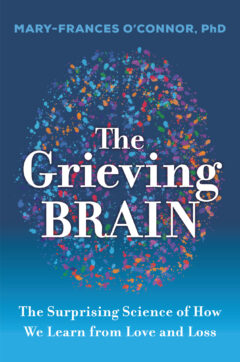Book Review: The Grieving Brain

WHEN WE’RE GRIEVING, it can be hard to make it through the day, much less appreciate the sophisticated tasks our brain is performing as we mourn. But understanding that grieving is actually a learning process can help us be patient with ourselves, writes Mary-Frances O’Connor in her new book, The Grieving Brain. “Grieving, or learning to live a meaningful life without our loved one, is ultimately a type of learning,” she notes. “Because learning is something we do our whole lives, seeing grieving as a type of learning may make it feel more familiar and understandable and give us the patience to allow this remarkable process to unfold.”
O’Connor is a researcher in the field of psychoneuroimmunology, which explores connections between the body’s nervous and immune systems and its psychological activity. She describes how during the grieving process, our brains are “trying to solve a problem when faced with the absence of the most important person in our life,” and makes a distinction between grief—those painful washes of emotion that ebb and flow—and grieving, which is the longer-term process of finding new ways to meet the attachment needs the person you’ve lost used to fulfill.
“You cannot go from arithmetic to calculus without many, many days of practicing multiplication tables and solving differential equations,” she says. “In the same way, you cannot force yourself to learn overnight that your loved one is gone … [but] taking in everything around us, which updates our virtual map and what our brain thinks will happen next, is a good start for being resilient in the face of great loss.”










